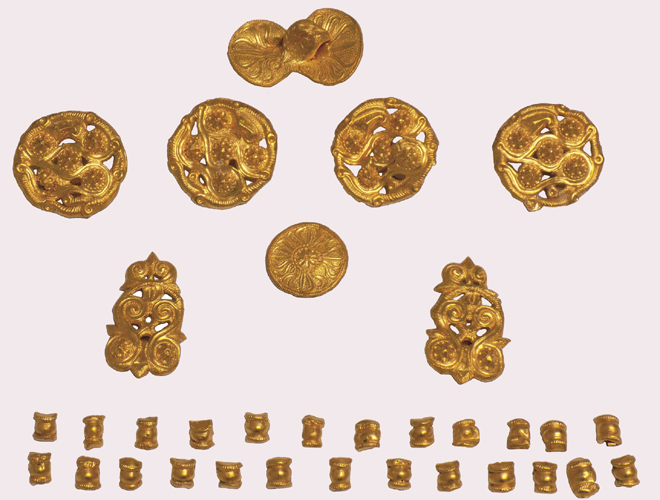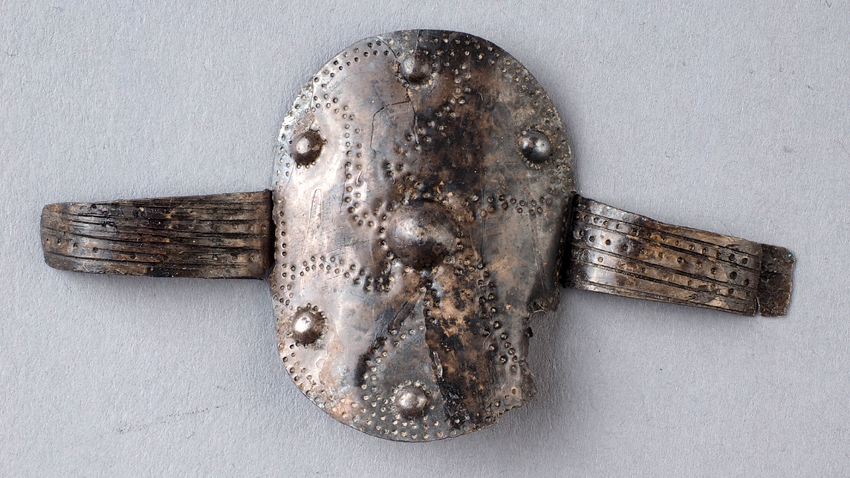A display is underway at the National Institute of Archeology with Museum (NIAM) in Sofia that features artefacts from the 2016 archeological season. It is the tenth such exhibition. The keyword of the current event is gold. There is a large number of gold objects showcased this time with both historical and artistic value that archeologists unearthed in 2016. Radio Bulgaria talked to Ass. Prof. Lyudmil Vagalinski, Director of the Institute:
 „This plenty of gold could be a coincidence. Overall the display presents 350 objects from 18 sites. The gold artefacts are dated to different eras of human history - from prehistory, through the Classical Antiquity to the Middle Ages. I am indeed impressed because it is unusual to unearth so much gold during planned or even rescue excavations. It seems last year we were lucky and we all know that the public gets excited with gold objects.”
„This plenty of gold could be a coincidence. Overall the display presents 350 objects from 18 sites. The gold artefacts are dated to different eras of human history - from prehistory, through the Classical Antiquity to the Middle Ages. I am indeed impressed because it is unusual to unearth so much gold during planned or even rescue excavations. It seems last year we were lucky and we all know that the public gets excited with gold objects.”
Ass. Prof. Vagalinski thanked his colleagues from the whole country who have cooperated for the presentation of this exhibition. Thirteen museums have gratuitously assisted the display with items dig out during the 2016 archeological season. This way it features items and posters from the total of 50 archeological sites.
The finds come from almost the entire territory of Bulgaria - from until recently obscure villages, through Antiquity cities such as the ancient Apollonia (present-day Sozopol on the Black Sea), Bulgaria's first capital in the Balkans Pliska, all the way to the city of Sofia.

 The timespan of found objects is impressive. The 18 sites go across eras starting with early prehistory (the late Paleolithic) to the Middle Ages, explains Assistant Prof. Kamen Boyadzhiev, head of Expositions Department at NIAM. He contends that the exhibitionalong with gold,also features a few valuable finds dated to prehistory. For example, last summer gold finds included one believed to be among the earliest gold finds in Europe. And here is another interesting detail: “One of the finds is perhaps one of the earliest silver objects known in Europe so far - it comes from the Haramiiska Dupкa cave in the southern Rhodope Mountains near the town of Devin”.
The timespan of found objects is impressive. The 18 sites go across eras starting with early prehistory (the late Paleolithic) to the Middle Ages, explains Assistant Prof. Kamen Boyadzhiev, head of Expositions Department at NIAM. He contends that the exhibitionalong with gold,also features a few valuable finds dated to prehistory. For example, last summer gold finds included one believed to be among the earliest gold finds in Europe. And here is another interesting detail: “One of the finds is perhaps one of the earliest silver objects known in Europe so far - it comes from the Haramiiska Dupкa cave in the southern Rhodope Mountains near the town of Devin”.
In a nutshell, the exhibition is golden but not only for the quantity of ancient gold. Its worth is also due to the array of finds from prehistory attesting its unexplored cultural wealth.
Ass. Prof. Vagalinski also announced a guest-exhibition planned for April of the celebrated gold treasure from Nagyszentmiklós, in the region of Banat, which used to be part of the Habsburg Empire. The treasure is kept at the Kunsthistorisches Museum in Vienna. The Nagyszentmiklós treasure is dated to the early Middle Ages and is often associated with the Proto-Bulgarians though there are other hypotheses about his origin as well.
 For the first time the original of this treasure will be put on display outside Vienna or Budapest. In its territory NIAM will complement the Nagyszentmiklóstreasure with a display about pagan Bulgaria revisiting the early period of the First Bulgarian Kingdom.
For the first time the original of this treasure will be put on display outside Vienna or Budapest. In its territory NIAM will complement the Nagyszentmiklóstreasure with a display about pagan Bulgaria revisiting the early period of the First Bulgarian Kingdom.
In the meantime, NIAM will present at Vienna's Kunsthistorisches Museum an exhibition of great historical value - focused on early goldmining and metallurgy in what is Bulgaria today. It provides interesting information about cultural development through the prism of metallurgy. The finds come from the old mine near Ada Tepe in the region of Krumovgrad in the Rhodope Mountains. “Goldmining here dates back to the second millennium BC, the Middle Bronze Age, which is earlier than the Trojan War”, concludes Ass. Prof. Lyudmil Vagalinski.
English Daniela Konstantinova
Photos: Veneta Pavlova and National Institute of Archeology with MuseumOn the eve of one of the brightest Bulgarian holidays – the Day of the National Awakeners, the Bulgarian Cultural Institute in London welcomed the guests of the Bulgarian National Radio in a meeting-conversation with Bulgarian poet Mirela Ivanova,..
On the eve of one of the brightest Bulgarian holidays - the Day of the National Awakeners of Bulgaria, the Bulgarian Cultural Institute in London is inviting Bulgarians living in the UK to a meeting-conversation with three contemporary artists -..
On 17 November 2025, the Finnish-Bulgarian Association will present the exhibition Nuuttipukki vs Kukeri in the city of Pori, Finland, as announced by the Bulgarian Embassy in Finland via its official Facebook page. The exhibition will take place at..

+359 2 9336 661
